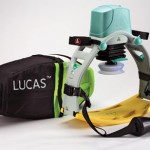When considering a career in lifesaving or aquatic safety in the United States, one critical question often arises for those trained in Canada: “Does Canadian lifesaving certification work in the US?” This query touches on the compatibility and recognition of lifesaving qualifications across borders, which is vital for professionals planning to work in different countries. Canadian lifesaving certifications, endorsed by reputable organizations like the Lifesaving Society of Canada, are highly regarded due to their rigorous training standards. However, transferring these certifications to the U.S. involves understanding specific regulatory requirements and potential re-certification processes. This article goes in-depth on the validity of Canadian lifesaving certifications in the U.S., detailing the necessary steps and considerations for those seeking to leverage their Canadian credentials in American aquatic environments.
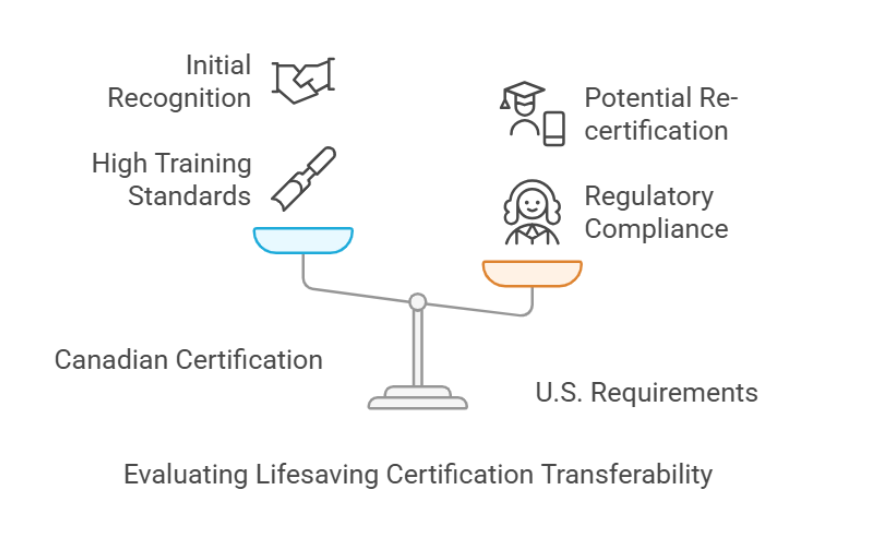
Does Canadian Life-Saving Certification Work in the US?
For Canadian lifeguards, first responders, and medical professionals looking to work or volunteer in the United States, the question of whether their Canadian life-saving certification is recognized is crucial. The Lifesaving Society of Canada, a leader in the field, ensures that its training programs adhere to high standards. However, the recognition of these certifications across the border isn’t automatic. In the U.S., life-saving standards and regulations can vary significantly from state to state and even between different regions within a state. This variability means that Canadian certifications might not meet all local requirements, and additional training or certification could be necessary. Understanding how these credentials translate is essential for those planning to operate in U.S. waters or healthcare settings. This section will go in-depth into the recognition, equivalency issues, and necessary steps for Canadians to validate or uplift their credentials for use in the United States, providing clarity and direction for these vital professionals.
Understanding Canadian Life-Saving Certification
Canadian life-saving certifications are comprehensive and designed to equip individuals with the skills to perform rescues and administer first aid in various emergencies. These certifications are offered through recognized bodies such as the Lifesaving Society, the Canadian Red Cross, and St. John Ambulance, each providing training programs tailored to different needs and environments. Here’s a closer look at some key certifications:
Bronze Cross
The Bronze Cross certification is a prerequisite for the National Lifeguard (NLS) certification and is aimed at individuals who have already completed the Bronze Medallion. It focuses on advanced rescue techniques, preparing lifeguards to handle complex rescue scenarios, and introduces the principles of emergency procedures and teamwork in lifesaving.
National Lifeguard Service (NLS)
NLS is a professional certification for lifeguards in Canada. It covers a comprehensive set of skills, including surveillance, rescue, first aid, and the management of spinal injuries. NLS holders are considered qualified to lifeguard pools, waterfronts, waterparks, and special events featuring water activities.
First Aid and CPR
First Aid and CPR certifications are crucial for the general public and healthcare and emergency response professionals. These certifications range from basic to advanced levels, including CPR for infants, children, and adults and the use of automated external defibrillators (AEDs). Training often includes managing airway, breathing, and circulation emergencies and providing care until medical help arrives.
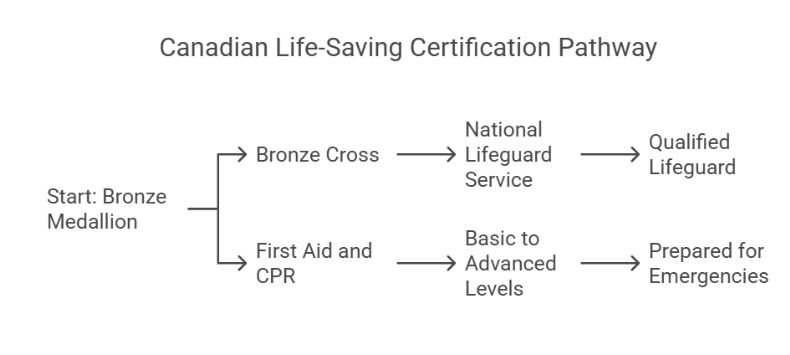
Life-Saving Certification Requirements in the US
Navigating the requirements for life-saving certifications in the United States involves understanding the roles of key organizations such as the American Red Cross, the American Lifeguard Association (ALA), and the Occupational Safety and Health Administration (OSHA). Each organization sets specific standards that address the question: “Does Canadian life-saving certification work in the US?”
American Red Cross
The American Red Cross offers various certifications crucial for lifeguards, first responders, and healthcare providers. These include Lifeguarding and Water Safety, CPR/AED for Professional Rescuers, and Advanced First Aid. Their programs are widely recognized nationwide and often serve as the benchmark for aquatic safety and emergency response training.
American Lifeguard Association
The ALA focuses on providing lifeguarding certification that meets national standards. This certification includes training in water rescue techniques, first aid, spinal injury management, and CPR, tailored to meet the requirements of pools, lakes, and coastal environments.
Occupational Safety and Health Administration (OSHA)
OSHA doesn’t directly certify lifeguards but sets workplace health and safety guidelines, including emergency services and first aid requirements. Compliance with OSHA guidelines is crucial for life-saving professionals working in industrial or public settings.
Overview of Certifications
In the U.S., certifications such as the Lifeguarding certificate, CPR for Healthcare Providers, and Advanced First Aid are essential. These certifications must be renewed periodically to maintain proficiency and compliance with the latest health and safety standards. The U.S. has no direct equivalent to Canada’s Bronze Cross, but the skills it covers are part of the training programs provided by U.S. organizations.
For Canadian professionals seeking to validate their life-saving credentials in the U.S., understanding these requirements and possibly undergoing additional training or re-certification is necessary to ensure their qualifications are recognized and applicable in various American jurisdictions.
Recognition of Canadian Certifications in the US
Whether the US recognizes Canadian lifeguarding, first aid, or CPR certifications is complex and varies by state and governing bodies. Understanding the equivalency and reciprocity agreements and state-specific requirements is essential for Canadian-certified individuals planning to work or volunteer in the U.S.
Equivalency and Reciprocity Agreements
While no universal agreements between Canada and the U.S. automatically recognize lifesaving certifications, some U.S. states and organizations may have specific agreements with Canadian certifying bodies. These agreements typically require verification of training standards and may sometimes necessitate additional testing or courses to bridge any gaps in training procedures or content.
State-Specific Requirements
Recognizing Canadian certifications in the U.S. can significantly differ from state to state. For instance, with their extensive coastlines and numerous aquatic facilities, California and Florida may require additional water rescue skills and environmental training that align with their local conditions. Meanwhile, New York and Texas might emphasize urban and controlled aquatic environments, focusing more on crowd management and emergency response in diverse scenarios.
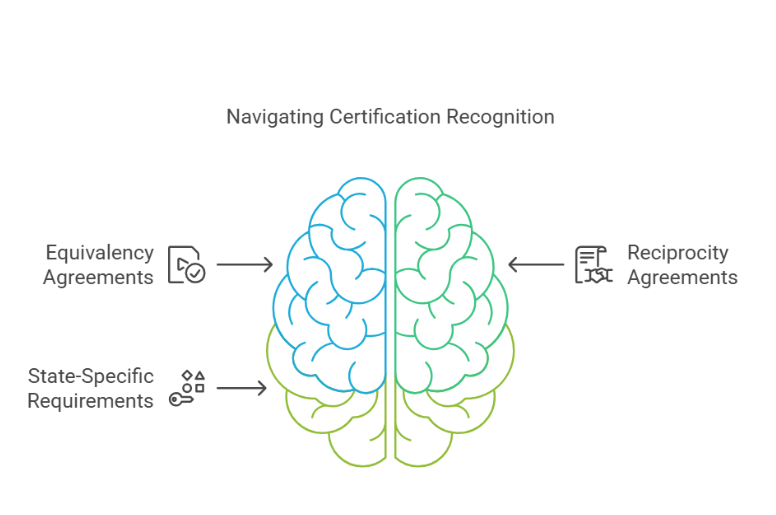
Steps to Work as a Lifeguard in the US with a Canadian Certification
For Canadian lifeguards aiming to work in the United States, navigating the process involves several steps, from document verification to potentially undergoing requalification exams. Understanding the conversion process for Canadian certificates and any additional training or exams required is crucial to streamline transition and compliance with U.S. regulations.
Document Verification and Requalification Exams
Initial steps include verifying your Canadian certifications with relevant U.S. bodies, such as the American Red Cross or the American Lifeguard Association. This might involve submitting your credentials for evaluation to determine their equivalency to U.S. standards. If discrepancies are found or updates are needed to meet the local regulations, requalification exams may be necessary to demonstrate proficiency and secure U.S. lifeguard certification.
Conversion Process for Canadian Certificates
To convert Canadian lifeguard certifications to be recognized in the U.S., individuals must typically engage with state-specific lifeguarding boards or national certifying agencies. This process includes submitting original Canadian certificates, completing application forms, and paying applicable fees. Some states or organizations may require a practical assessment or orientation to local laws and environmental conditions.
Additional Training or Exams Needed
Additional training or exams might be required depending on the state and the specific type of lifeguarding role. For instance, Canadian lifeguards may need to take supplementary courses on ocean rescue techniques if they plan to work on U.S. beaches or advanced life support courses if they work at facilities that require a higher level of medical preparedness. These courses ensure that all lifeguards meet the comprehensive safety standards expected in different U.S. jurisdictions
Jobs You Can Apply for in the US with Canadian Certification
With Canadian life-saving certifications, several roles become accessible in the US, though the exact nature of the job and its requirements can vary by state and employer. Lifeguarding positions are common, particularly at pools, beaches, and resorts, where there is a constant need for qualified personnel to ensure swimmer safety. First responder roles, like emergency medical technicians (EMTs) or paramedics, often require additional certification, but having a Canadian life-saving background provides a strong foundation. Swimming instructor positions are also viable, as these roles typically require proof of proficiency in swim techniques and safety protocols covered under Canadian training programs. However, it’s essential to check local regulations and potential employers about the need for any supplementary certifications or training specific to the U.S.
Differences Between Canadian and US Life-Saving Standards
While Canadian and US life-saving standards aim to prepare individuals for emergency response, there are notable differences in training and procedures. The Canadian system often emphasizes a comprehensive approach to first aid and rescue techniques suited for a variety of environments, including icy waters, which are less common in the U.S. U.S. standards, on the other hand, might focus more on specific scenarios relevant to local conditions, such as rip current rescue operations in coastal areas or advanced medical response techniques in urban settings. Additionally, the regulatory framework and oversight can differ significantly- the U.S. has a more decentralized approach with standards varying widely between states, whereas Canada generally maintains a consistent standard nationwide. Understanding these differences is crucial for Canadians seeking life-saving roles in the U.S., as it may necessitate additional training or adjustments to their existing qualifications.
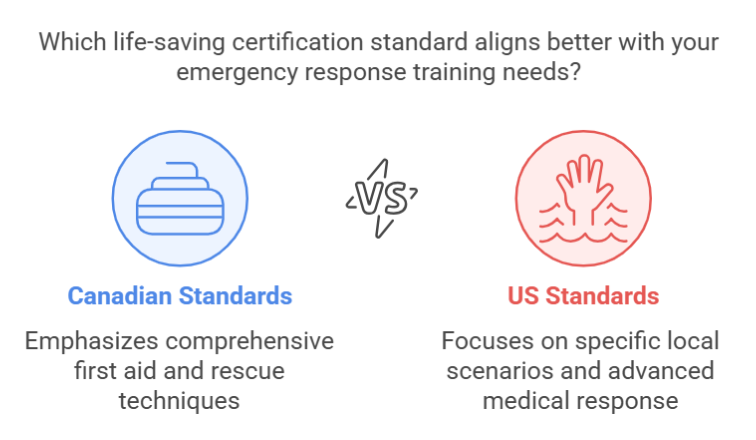
How to Strengthen Your Job Application as a Certified Lifeguard
To uplift your job application as a certified lifeguard, especially when questioning if your Canadian life-saving certification is applicable in the US, start by writing the resume such that it highlight your specific skills and experiences in life-saving and first aid. Clearly explain the scope and validity of your Canadian certifications and how they relate to US standards. In the resume and cover letter, emphasize any additional training or achievements, such as handling eemergenciesor special certifications like AED or CPR. Prepare for interviews by being ready to discuss specific scenarios where you’ve successfully applied your skills. Research standard life-saving practices and recent changes in US life-saving protocols to demonstrate your commitment and adaptability to prospective employers.
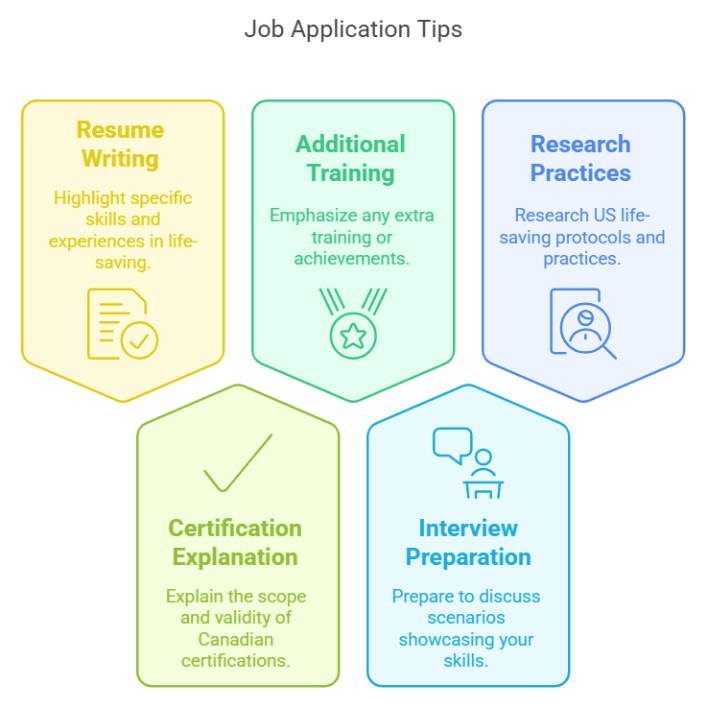
Cost and Time Involved in Certification Transfer
Transferring Canadian life-saving certifications to US equivalents can involve significant costs and time. Fees for evaluating and processing Canadian certifications can vary, often depending on the state and the certifying body involved. The time frame for transferring certifications typically ranges from a few weeks to several months, depending on the complexity of the verification process and the need for additional training or exams. Applicants should prepare for this by budgeting for monetary costs and the potential wait times, ensuring all documents get accurately prepared and submitted to avoid delays.
Alternative Pathways if Your Certification Isn’t Recognized
If your Canadian life-saving certification is not recognized in the US, consider fast-track certification options available through major US organizations like the American Red Cross or the American Lifeguard Association. These programs often offer accelerated courses that cover lifeguard training, CPR, and first aid, specifically tailored to meet US standards and fill any gaps in international certifications. These courses can often be completed in a few days to weeks, providing a swift pathway to gaining recognized qualifications and improving employability in various aquatic environments across the United States.
FAQs
-
Do US employers accept Canadian lifeguard certification?
Some US employers may accept Canadian certifications, but additional local certification may often be required. -
How can I convert my Canadian certification to a US-recognized one?
Conversion typically involves taking supplemental courses or exams through US organizations like the American Red Cross. -
Do I need a visa to work as a lifeguard in the US?
Yes, non-US citizens need a work visa to be employed as a lifeguard in the United States. -
Are Canadian first-aid certifications valid in the US?
Canadian first-aid certifications are generally recognized, but some states or employers may require additional US-specific certification. -
Can I apply for lifeguard jobs in all US states with Canadian certification?
You can apply, but some states may require additional certifications or state-specific training. -
What is the cost of transferring a Canadian certification to the US?
Costs vary but can include fees for evaluation, exams, and courses, potentially totaling several hundred dollars.
Final Thought
While Canadian lifeguarding, first aid, and CPR certifications are respected for their rigor and comprehensiveness, transferring these credentials for use in the United States can require additional steps, including verification, supplemental training, and possibly re-certification, depending on state-specific requirements. Whether you plan to work as a lifeguard, a first responder, or in a healthcare setting, understanding and navigating the certification landscape are crucial. If you need to update or supplement your Canadian certifications to meet U.S. standards, consider contacting Simple CPR. They have various courses tailored to help professionals like you quickly achieve American accreditation. Visit Simple CPR today to learn about their training options and ensure you meet all the qualifications to work in the US.


